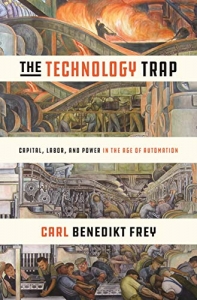
The Technology Trap: Capital, Labour and Power in the Age of Automation. Carl Benedikt Frey. Princeton University Press. 2019.
It seems that barely a month can pass without new forecasts of technology-induced job losses hitting the front pages. The Office for National Statistics are at it, Deloitte, PricewaterhouseCoopers, the Organisation for Economic Co-operation and Development (OECD); the World Bank even dedicated their most recent World Development Report to the future of work. Fittingly, it was Carl Benedikt Frey and Michael Osborne who turbo-charged the automation debate back in 2013 when their paper estimated that 47 per cent of US employment is at risk of computerisation within the ‘next decade or two’.
Frey, who now directs the Future of Work Programme at the Oxford Martin School and is considered a world-leading scholar on the impact of automation, has further explored the implications of technological change in his new book, The Technology Trap: Capital, Labour and Power in the Age of Automation. Thankfully there are no new predictions about the extent of job losses and the book reads as a tour de force of the very latest research on automation and its consequences. Ultimately, the author’s premise is simple – whether workers lose their job to robots ultimately depends on ‘the societal distribution of political power’ (xiii).
To demonstrate this, Frey takes the reader on a long sweep of industrial history in the UK and the US dating back to the onset of the Industrial Revolution. Frey’s argument rests on the distinction between labour-enabling technologies and labour-replacing technologies. As the names suggest, labour-enabling technologies complement workers, boosting productivity and opening up avenues for new employment, while labour-replacing technologies boot workers out of the labour market entirely, forcing them to re-skill or search for other opportunities.
The Technology Trap serves as a timely reminder that while technological change may benefit everyone over the long run, ‘short run’ adjustment costs can represent a lifetime for some workers. In detailing the history of the British Industrial Revolution, Frey highlights that ‘in the period 1780-1840, output per worker grew by 46 percent. Real weekly wages, in contrast, rose by a mere 12 percent’ (113). Income inequality grew and workers generally saw no improvement in their standard of living for decades. This period of history became known as ‘Engels’ Pause’ and ultimately led to the Luddite uprisings of the early nineteenth century.
However, as the book moves through time, and on to the second Industrial Revolution, we are presented with a completely opposing picture. Workers tended to benefit from the introduction of technology. As Frey notes: ‘factory electrification allowed workers to produce more and thus earn more. Instead of raging against the machine, workers and trade unions battled to maximise their gains from progress’ (190). The explanation for this reversal of fortunes rests on the adoption and proliferation of so-called labour-enabling technologies amid a general period of ‘welfare capitalism’, which is defined as ‘the era of collective economic rights created by the New Deal’ (200).
Unfortunately, this era of collective progress is unlikely to repeat itself in the current age. As Frey writes, ‘the great reversal’ has seen the percentage of men aged between 25 and 54 who go to work in the morning plummet since the new millennium while opportunities for high school graduates (those without a university degree) have diminished. The future, then, is increasingly looking like the past and, as the author writes:
“If Friedrich Engels were living today, what would he have written about the computer era? Working conditions in the industrial west clearly do not have much in common with the ‘‘dark, satanic mills.’’ But the trajectories of per capita output and people’s wages look exceedingly similar. In America, labour productivity has grown eight times faster than hourly compensation since 1979. Even as the American economy has become much more productive, real wages have been stagnant, and more people are out of work; consequently the labour share of income has fallen. Corporate profits have swept up an ever-greater share of national income while the share going to workers has rarely been smaller.” (244)
The key question, of which I am not sure the book offers a full explanation, is what accounts for this difference? Why are we now looking at a tendency towards labour-replacing technologies when we once had a proliferation of labour-enabling ones? There is mention of growing income and wealth disparities, yet the book lacks, perhaps, a fuller detailing of the political economy of inequality since the 1980s – there is very little mention of Margaret Thatcher and/or Ronald Reagan, strict anti-union legislation, corporate governance (or lack of) and declining rates of income and corporate taxation. These all seem relevant to a context in which workers risk not benefiting from an age of automation.
For a fuller explanation, we need to arguably travel beyond two outdated paradigms in which Frey’s work seems stuck. The first is what Isabelle Ferreras has called the ‘liberal economic theory of the firm’. This theory posits that free-market economics, and the institutions that uphold them, have propagated the idea that modern firms are organisations built to pursue a single goal – to generate return for capital investors. Ferreras maintains that such a position conveniently masks the fact that workers are equal partners in firms as they invest their time and labour in them, yet are hamstrung by the ‘despotic power’ of capital investors. This vast imbalance of power between capital and labour should therefore be positioned within the democratic deficit that exists in today’s world of work.
Frey also seems to fall into the trap of believing that any job is better than no job at all. The predominant danger of automation and artificial intelligence is framed as people falling out of the labour market entirely and there is little mention of the rise of poor quality or insecure jobs. While there is reference to jobs ‘where the productivity ceiling is low’ (237), the overriding sense is a binary that dichotomises employment as good and unemployment as bad. This overlooks a growing body of evidence that bad quality jobs can be worse for our health than unemployment as well as the increasing popular demand for shorting working weeks. It feels like a big omission since there is no discussion in the book of the emergent ‘post-work’ literature or, in the words of Andre Gorz, ‘working less so everyone can work’.
Trapped in these paradigms, the final section of the book, which focuses on solutions for the age of automation, falls a little flat. Suggestions for relocation vouchers for people to move from areas of low job creation to more affluent areas seem like a sticking plaster over the gaping wound that is an economic system that ‘accumulates by dispossession’. Why, for instance, should someone have to move from Blackpool to Manchester or London? Should the focus not be on making all of our hometowns compatible with a decent quality of life in the first place?
Frey’s point, however, about the importance of education should send alarm bells ringing in the UK. In the so-called race between technology and education, current budget cuts amid a general slowdown in human capital accumulation will present workers (both present and future) with even greater troubles ahead. While The Technology Trap may leave readers with more questions than answers, it is an excellent and unique reminder that the future of work will depend on policy choices made in the present. As perhaps the most comprehensive account of automation to date, it deserves to be read widely.
♣♣♣
Notes:
- This blog post appeared originally on LSE Review of Books.
- gives the views of its author, not the position of LSE Business Review or the London School of Economics.
- Featured image: Female workers at the Queensland Tropical Fruit Produce Cannery, Northgate, 6 March 1948 (Queensland State Archives Digital Image ID 23023, Public Domain)
- Before commenting, please read our Comment Policy
Liam Kennedy is a freelance researcher and commentator whose work focuses on UK inequality, social mobility and public perceptions of them. He tweets @liamkennedy92.


 Find this book:
Find this book: